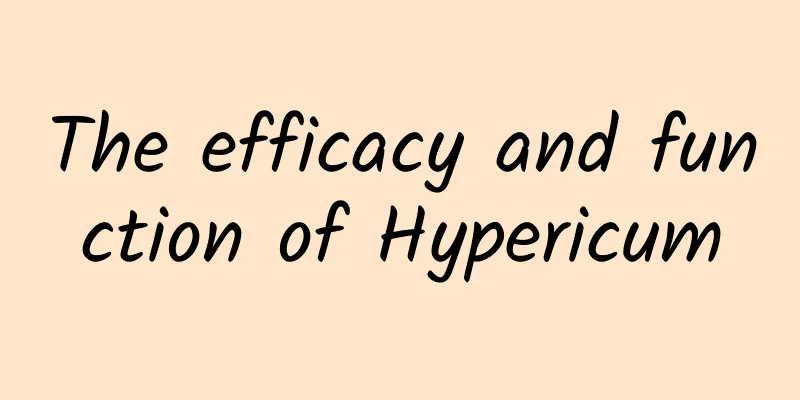The efficacy and function of Hypericum

|
Hypericum erythrorhizon is a traditional Chinese medicine. In addition to the effects we know in daily life, Hypericum erythrorhizon actually has many other effects and functions. Let’s take a look at them right away. [Alias] Hypericum, pig thumb willow, wild forsythia, grain in ear flower, yellow flower fragrance, gardenia, broken bowl flower, passing yellow, big leaf yellow, big field edge yellow, yellow wood, golden fragrance, Dragon Boat Festival flower. [Source] Medicinal material source: the whole plant of Hypericum dasyphyllum of the Garcinia family. [Original form] Hypericum shrub, 0.3-1.5m high. The whole plant is hairless. Branches with 2 or 4 longitudinal ridges, brown or reddish brown. Simple leaves are opposite; petioles are short; leaf blades are ovate, ovate-oblong or lanceolate-oblong, 1.5-6cm long, 0.5-3cm wide, green above, pink-green below, with faintly visible reticular veins and transparent glandular dots scattered all over. Inflorescence cymose or solitary, with 1-15 flowers; sepals broadly ovate to rounded, apex rounded or slightly concave, usually with a small apices, margins dry membranous, with fine teeth or ciliates, straight when fruiting; petals yellow or golden yellow, broadly ovate to oblong-obovate or broadly obovate, falling off; stamens 5 bundles, each with 50-70 stamens, anthers light yellow; ovary ovoid, 5-chambered, style nearly as long as ovary or slightly shorter than ovary, separated from base, curved downward near apex. Capsule ovoid. The seeds are cylindrical, dark brown, with slender, membranous narrow wings on one side and inconspicuous fine honeycomb patterns on the surface. The flowering period is May-June, and the fruiting period is July-August. [Habitat distribution] Ecological environment: Grown on hillsides at an altitude of 2700m, grasslands, under forests, in bushes or open places. 【Nature and flavor】 Bitter; Cold 【Meridian】 Liver; Kidney; Bladder 【Functions and indications】 Clears away heat, promotes dampness and detoxifies; soothes the liver and dredges the meridians; removes blood stasis and relieves pain. It is mainly used for damp-heat gonorrhea, hepatitis, cold, tonsillitis, hernia, tendon and bone pain, and traumatic injury. [Usage and Dosage] For oral use: decoction, 6-15g. For external use: take appropriate amount and mash it for application; or fry and grind it into powder and sprinkle it on. 【Excerpt】 Chinese Materia Medica Regarding the Hypericum introduced in the article, I hope everyone can learn more about the relevant information in daily life, so that they can correctly treat the disease when facing it. |
<<: The efficacy and function of money tangerine cake
>>: The efficacy and function of golden silk plum
Recommend
Effects of raw Rehmannia root after being processed into mature Rehmannia root
Cooked Rehmannia root is made from raw Rehmannia ...
I've heard of conjoined twins, but why do conjoined animals always seem uncommon?
Humans have conjoined twins, but it seems that we...
Nutritional value of chicken head rice
Chicken head rice, which we call water chestnut i...
What are the effects and functions of fossil grass?
If we talk about which plant is more tenacious, f...
The efficacy and function of red sunflower
Do you know red sunflower? It is a common Chinese...
The efficacy and function of Evodia rutaecarpa fruit
Evodia rutaecarpa fruit is a very common Chinese ...
The efficacy and function of white chrysanthemum root
White chrysanthemum root is a kind of traditional...
Find out! Grass carp originated in western China 33 million years ago
Grass carp is one of the four major freshwater ca...
Perilla leaf foot bath
What are the effects of soaking feet in perilla l...
Many parts of my country have entered "barbecue" mode, and climate warming is the "culprit"
Recently, with the strong summer heat, many parts...
In the wars of unification of ancient Chinese dynasties, why was Zhu Yuanzhang the only one who could unify China from south to north?
Although great unification was the mainstream and...
I suddenly felt dizzy, but it was gone in a few seconds. What happened? Huaxi doctor: The reason may be the ear...
Have you ever experienced I got up from the bed a...
What is the function of snow lotus?
At present, snow lotus is a very good health-care...
Man Jiang Hong, what is red?
A River Full of Red: Writing Thoughts (Song Dynas...









